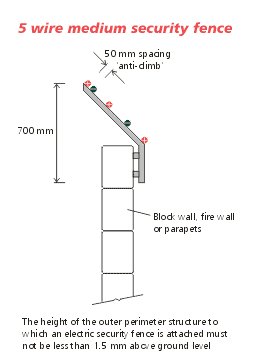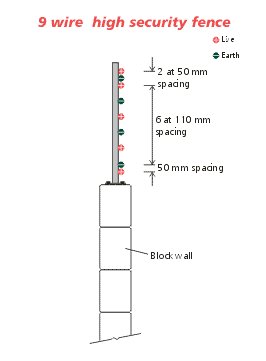Array Wiring
Array Wiring
SETTING UP THE FENCE WIRES
It’s recommended the 12 volt DC fence charger, battery, and battery charger be mounted indoors and out of view from intruders, thus concealing the location of the power source of the electrically energized fence. Improved security is to lock it in a box, inaccessible to unauthorized personnel.
All wires including the ground return wires and the high voltage wires are to be installed and mounted on insulators. This is necessary to complete the psychological component and so the trespasser cannot distinguished the ground wires from the high voltage wires.
The maximum spacing between the wires should be approximately 6 inches, or about 15 centimeters. This has been tested and shown to be the most effective spacing to deter people from trying to go over or through the fence.
.
The fence should be designed and installed with an even number of charged wires to provide a loop so that the entire fence will be monitored. Alternate wires should be connected to earth ground.
However, when there is an excessive amount of foliage around the fence, the top wire might be a ground wire. This is to reduce the number of faults when the high voltage wire is partially shorted with fronds or branches which may fall or be blown across the fence.
Various shapes and angles are designed into the fence which depend on the type of fence desired, keeping in mind both the aesthetic concerns, as well as the security concern.
.
ADDITIONAL HELPFUL INFORMATION
This Sketch in PDF format shows the Grounding Rod Detailes (click here – open in new window)
Interconnection of the ground rods – the Earth Ground Network – sketch in PDF (click here – open in new window)
Wiring a gate into the electric perimeter system – sketch #1 in PDF (click here – open in new window)
Wiring a gate into the electric perimeter system – sketch #2 in PDF (click here – open in new window)
Click the button to print the current page.

